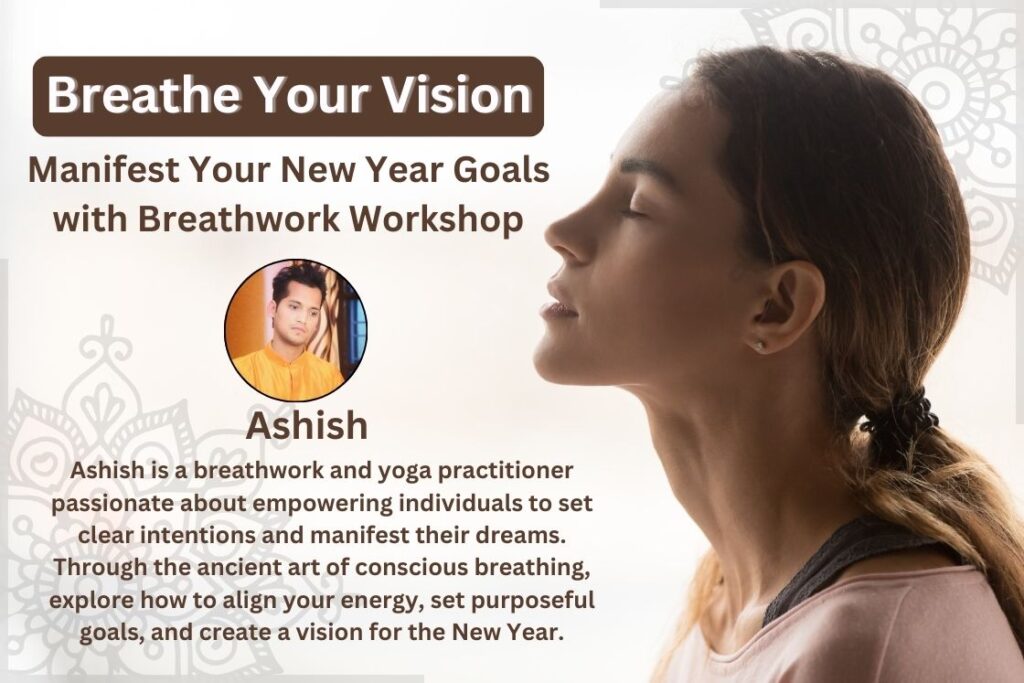
[ad_1]

Pranayama and breathwork, although typically used interchangeably, signify distinct branches within the huge panorama of yogic practices. As we delve into the intricacies of those practices, it turns into obvious that they don’t seem to be mere synonyms however embody distinctive philosophies and methodologies.
Pranayama, rooted in historical yogic traditions, includes aware management of the breath to boost the move of life drive power—known as Prana. However, breathwork, a time period gaining recognition past conventional yoga circles, encompasses varied methods aimed toward altering respiration patterns to attain particular bodily, psychological, or non secular outcomes.
The aim of this text is to unravel the refined but important variations between pranayama and breathwork, dispelling frequent misconceptions that always blur the traces between these practices. As we navigate by this text, we goal to offer readability, permitting you to discern the distinct qualities of every strategy and harness their transformative potential for holistic well-being.
Understanding Pranayama
Pranayama is an integral a part of yoga. It combines the Sanskrit phrases “Prana” (life drive) and “yama” (management), signifying the aware regulation of breath to channel important life drive.
Originating from historical Indian philosophy and detailed in texts just like the Yoga Sutras, pranayama serves as an important limb within the holistic follow 8 limbs of yoga. Methods inside pranayama goal to purify power channels known as Nadis, fostering a harmonious connection between thoughts, physique, and spirit.
As a transformative follow, pranayama extends past mere breath management, providing a pathway to heightened consciousness and non secular development.
Conventional Pranayama Varieties and Their Significance
- Nadi Shodhana (Alternate Nostril Respiratory): Among the many foundational pranayama methods, Nadi Shodhana includes alternate nostril respiration to steadiness the move of prana. This follow goals to purify the power channels, selling psychological readability and steadiness.
- Kapalbhati (Cranium Shining Breath): Kapalbhati is a dynamic yoga respiration train the place forceful exhalations cleanse the lungs and energize the physique. This method is understood for its invigorating results on each the respiratory and digestive methods.
- Bhramari (Bee Breath): Bhramari includes producing a buzzing sound throughout exhalation, making a soothing impact on the nervous system. This follow is famend for lowering stress, calming the thoughts, and selling a way of tranquility.
- Ujjayi (Victorious Breath): Ujjayi, characterised by a mushy hissing sound throughout each inhalation and exhalation, enhances focus and consciousness. It’s typically included into varied yoga sequences to deepen the meditative facets of the follow.
Incorporating these conventional pranayama methods into one’s follow holds profound advantages, fostering bodily well-being, psychological readability, and a deeper connection to the inside self.
Position of Pranayama in Yoga and Religious Improvement
Pranayama performs a pivotal function within the holistic journey of yoga and non secular growth. Past its instant physiological results, pranayama serves as a bridge between the bodily and psychological dimensions of yoga follow.
In yoga, pranayama acts as a catalyst for harmonizing the thoughts, physique, and spirit. By regulating the breath, practitioners domesticate a heightened consciousness of the life drive power inside, fostering a way of steadiness and equanimity. This enhanced self-awareness turns into a stepping stone for delving deeper into meditation and self-realization.
On the trail of non secular growth, pranayama is considered a transformative device. It opens doorways to expanded states of consciousness, offering a way for people to attach with their innermost selves and the common power that permeates all existence. The rhythmic dance of breath in pranayama turns into a sacred follow, guiding practitioners in direction of self-discovery and a profound sense of interconnectedness with the cosmos.
Unveiling Breathwork

Origins and Evolution of the Time period “Breathwork”
The time period “breathwork” has gained prominence past conventional yogic circles, representing a broader spectrum of practices centered on intentional manipulation of breath. Whereas not rooted in historical yogic texts, the idea of breathwork attracts inspiration from varied cultural and therapeutic traditions.
The evolution of breathwork as a definite discipline may be traced to the mid-Twentieth century, with pioneers like Leonard Orr and Stanislav Grof contributing considerably. Leonard Orr, recognized for growing Rebirthing Breathwork, emphasised the therapeutic potential of aware respiration. Stanislav Grof, a psychiatrist, explored breathwork as a way of accessing altered states of consciousness for psychological therapeutic.
Definition of Breathwork
Breathwork refers to a variety of practices that deliberately modify respiration patterns to attain particular bodily, psychological, or non secular outcomes. Not like pranayama, which is deeply rooted in yogic philosophy, breathwork encompasses a various array of methods that draw inspiration from varied cultural, therapeutic, and non secular traditions.
The essence of breathwork lies in its inclusive nature, transcending cultural and philosophical boundaries. It invitations people to discover the transformative energy of breath in numerous methods, acknowledging that the breath serves as a bridge between the aware and unconscious realms of our being.
Breathwork Practices and Methods
Breathwork encompasses a wide range of practices designed to deliberately modify respiration patterns for particular outcomes.
- Holotropic Breathwork: Developed by Stanislav Grof, Holotropic Breathwork includes fast and deep respiration to induce altered states of consciousness. This method goals to entry the deeper layers of the psyche, selling therapeutic and self-exploration.
- Transformational Breathwork: Based by Dr. Judith Kravitz, Transformational Breathwork emphasizes a related, aware respiration sample to boost bodily, emotional, and non secular well-being. This follow is commonly utilized for stress reduction, elevated power, and emotional launch.
- Rebirthing Breathwork: Pioneered by Leonard Orr, Rebirthing includes aware related respiration to launch suppressed feelings and trauma. It’s named for the concept the method simulates the breath patterns of a new child, symbolizing a rebirth of the person.
- Integrative Breathwork: Drawing from varied breathwork traditions, Integrative Breathwork combines completely different methods to create a personalised strategy for practitioners. This adaptable technique permits people to tailor their follow to particular wants, whether or not for rest, self-awareness, or private development.
These numerous breathwork practices showcase the expansive nature of this discipline, providing people a spectrum of instruments to discover and improve their well-being, private development, and non secular journey.
Key Variations between Pranayama and Breathwork
Pranayama and breathwork, whereas each involving aware regulation of breath, differ considerably of their origins, philosophies, and purposes.
1. Philosophical Roots and Cultural Contexts: Pranayama is deeply embedded in historical yogic philosophy, tracing its roots to Indian traditions just like the Yoga Sutras. It displays a non secular and holistic strategy, emphasizing the management of breath for regulating Prana (life drive power). In distinction, breathwork, with a extra modern origin, attracts inspiration from varied cultural and therapeutic traditions aimed toward altering respiration patterns to attain particular bodily, psychological, or non secular objectives.
2. Intent and Objectives of the Practices: Pranayama, throughout the context of yoga, has final goal of non secular growth, power purification, and the combination of thoughts, physique, and spirit. It aligns with the broader yogic aim of self-realization. However, breathwork encompasses a variety of intentions, together with stress discount, emotional launch, and private development, making it adaptable to numerous wants past the non secular realm.
3. Methods and Approaches: Pranayama methods are firmly rooted in yogic scriptures, with particular methodologies like Nadi Shodhana and Ujjayi, every serving a singular objective within the yogic journey. In distinction, breathwork presents a extra eclectic mixture of methods, with practices like Holotropic Breathwork and Rebirthing Breathwork, every designed for particular therapeutic or experiential outcomes.
4. Respiratory Patterns and Rhythms: Pranayama typically includes particular breath patterns, comparable to managed inhalations, exhalations, and breath retentions, aiming to channel prana in a selected approach. In distinction, breathwork might incorporate assorted respiration patterns, from rhythmic to intense, relying on the precise method employed. The emphasis is on intentional breath manipulation for numerous functions.
Understanding these key variations supplies readability for practitioners in search of to interact with both pranayama or breathwork, recognizing the distinctive qualities and purposes every follow brings to the realm of holistic well-being.
Step into the brand new 12 months with objective! Be a part of our “Breathwork for Aim Setting and Manifestation” workshop, mixing historical knowledge and trendy practices. Manifest your aspirations in 2024 – examine workshop particulars.

The Breathwork Instructor vs. Pranayama Instructor
Within the realm of guiding others by breath-related practices, whether or not pranayama or breathwork, distinctions exist between lecturers based mostly on {qualifications}, scope of follow, and understanding of scholar wants.
A. {Qualifications} and Coaching Variations: Pranayama lecturers usually bear coaching deeply rooted in yogic philosophy, typically inside conventional yoga instructor coaching packages. This coaching contains an in-depth examine of historical texts, anatomy, and the nuances of pranayama methods. In distinction, breathwork lecturers might have numerous backgrounds, together with therapeutic coaching, psychology, or various therapeutic modalities. Their coaching typically focuses on particular breathwork methods and their purposes in trendy contexts.
B. Scope of Observe and Experience: Pranayama lecturers excel in guiding college students by the normal yogic path, providing insights into the non secular and philosophical dimensions of breath management. They might combine pranayama seamlessly into broader yoga practices. Breathwork lecturers, however, specialise in a variety of breath manipulation methods past yogic traditions. Their experience lies in adapting breathwork practices to therapeutic, emotional, or private growth contexts.
C. Understanding the Wants of College students in Completely different Contexts: Pranayama lecturers are attuned to the non secular and holistic aspirations of their college students throughout the yogic framework. They cater to people in search of a deeper reference to themselves and the non secular dimensions of life. Breathwork lecturers, whereas acknowledging non secular dimensions, are sometimes extra centered on addressing particular psychological or emotional wants. They information college students by breathwork practices that facilitate stress reduction, emotional launch, and private development.
Recognizing the variations between a breathwork instructor and a pranayama instructor permits people to decide on a information aligned with their particular objectives and intentions, whether or not rooted in conventional yogic paths or extra modern, therapeutic approaches.
Debunking Myths and Misconceptions
A. Addressing Frequent Misconceptions about Pranayama and Breathwork: One prevalent false impression is the interchangeable use of the phrases pranayama and breathwork. Whereas each contain aware respiration, they stem from distinct philosophies and have completely different objectives.
Pranayama is deeply rooted in yogic traditions, emphasizing non secular growth, power management, and the combination of thoughts, physique, and spirit. However, breathwork, with its numerous origins, serves a broader spectrum of intentions, together with stress discount, emotional therapeutic, and private development.
B. Clarifying the Distinctions By means of Sensible Examples: To dispel confusion, it’s important to offer sensible examples of every follow’s methods. As an illustration, demonstrating Nadi Shodhana as a pranayama method with a particular non secular intent, and contrasting it with a breathwork method like Holotropic Breathwork, which could give attention to therapeutic results and altered states of consciousness, helps illuminate the variations.
C. Highlighting the Complementary Features of Each Practices: Slightly than pitting pranayama in opposition to breathwork, recognizing their complementary nature is essential. Whereas pranayama presents a profound non secular journey throughout the yogic framework, breathwork supplies versatile instruments for emotional launch, stress reduction, and private exploration. Collectively, they contribute to a holistic strategy to well-being, catering to the varied wants of practitioners on their particular person paths.
In debunking myths and clarifying misconceptions, we goal to foster a extra nuanced understanding of those practices, permitting practitioners to interact with both pranayama or breathwork with higher consciousness and objective.
Conclusion
In essence, pranayama and breathwork, whereas each involving intentional breath management, diverge of their origins, philosophies, and supposed outcomes. Pranayama, rooted in historical yogic traditions, presents a non secular journey, whereas breathwork, with its modern roots, spans therapeutic and private development domains.
Frequent misconceptions typically blur the distinctions between pranayama and breathwork. By dispelling these myths, we emphasize their distinctive qualities and purposes. Understanding that pranayama leans in direction of non secular development, whereas breathwork caters to numerous intentions, encourages a extra knowledgeable engagement with these practices.
As practitioners navigate the realms of pranayama and breathwork, a aware strategy is essential. Slightly than seeing them as mutually unique, recognizing the complementary nature of those practices permits for a extra holistic well-being journey. Whether or not drawn to the non secular dimensions of pranayama or the therapeutic facets of breathwork, people are invited to discover and combine these practices with a nuanced understanding, fostering a transformative and customized strategy to self-discovery.
[ad_2]